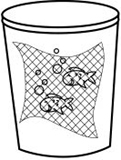Go Fish!: Teacher Notes


![]()
MA.7.A.1.1
![]()
Conceptual Understanding
Data Collection
Interpret Data
Proportional ReasoningProcedural Knowledge
Solve Proportions
![]()
Problem Solving
Reasoning
Communication
Connections
Representation
![]()
Imagine that you are asked to determine the number of fish in a nearby pond. To count the fish one by one, you could remove the fish from the pond and stack them to one side, or mark each fish so you would not count them over and over again. Counting like this could be hazardous to a fish's health!
To determine the number of animals in a population, scientists often use the capture-recapture method. A number of animals are captured, carefully tagged, and returned to their native habitat. Then a second group of animals is captured and counted, and the number of tagged animals is noted. Scientists then use proportions to estimate the number in the entire population.
![]()
Students work in groups of three to four.
![]()
Each group needs:
- 1 paper lunch sack - represents
the "lake"
- A supply of goldfish crackers
- represent the "fish" in the lake
- A supply of pretzel fish
crackers - represent the "tagged fish"
- 1 styrofoam cup - represents
the "net"
- 1 paper plate
![]()
- Collect the Data
Capture:- Each team receives a paper lunch bag with goldfish crackers inside.
- With the "net," scoop a sample of goldfish out of your "lake" onto the paper plate.
- Replace your sample of goldfish with pretzel fish. These are your "tagged" fish.
- Count the number of "tagged" (pretzel) fish and then return them to the bag.
- There are _____ tagged fish in the entire lake.
- Shake the bag gently.
- For the first casting, use your net (cup) to remove a sample of fish. Count the number of "tagged" (pretzel) fish in your sample and record the total in the first column below.
- Return all of these fish to the lake (bag) and shake gently to mix them up.
- Repeat this process until you have gathered information on 10 samples and filled in the table below.
Sample NumberNumber of Tagged Fish in SampleTotal Number of Fish from Sample12345678910Average
- Analyze the Data
- To find the AVERAGE number of tagged fish, add up all 10 samples of the tagged fish and divide by 10. Do the same thing to find the AVERAGE number of total fish in your samples. (Using the AVERAGE number with 10 samples is more reliable than using any one sample's data.)
- Use the proportion below to estimate the total number of fish
in your lake:
Average # tagged in samples=Total # tagged in lakeAverage # in samplesTotal # fish in lake
ESTIMATED POPULATION: _____________________
- Now count the total number of fish in your lake to determine
how close your estimate from the "sampling" is to the
actual number of fish in the lake.
ACTUAL POPULATION: _____________________
- How close were you to the actual number of fish?
![]()
As a result of this activity, students learn how to gather information about a large population based on a representative sample whose makeup is similar.
![]()
- Where else would scientists use this capture/recapture method?
- What are some of the factors that could have caused an estimate to be close or not so close to the actual number of fish?